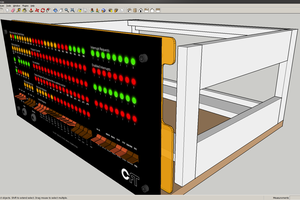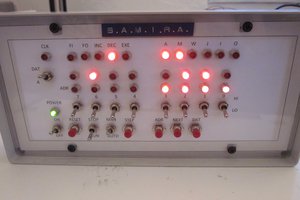You can use NeuronZoo now at www.NeuronZoo.com !
- You can configure the brain cells to perform almost every function.
- Explore minimalism. The brain cells can execute only 3 instruction types.
- Execution speed is selectable. SingleStep is also possible.
- It can be used in education, or just for fun.
Click on "manual" in the Help menu of NeuronZoo, to access the full description.
The brain cells are very different from your typical computer system or CPU:
- no built-in knowledge of numbers (not even binary)
- no logic operations like AND, OR
- no separation between "cpu" and memory
- no "data word width" concept
In the Neuronzoo project, the neurons are like software objects. The eight out-going connections of a neuron, Axons, are like eight fields within the object structure, that can contain pointers to other objects. The neurotransmitters are like processor registers that point to a certain object. Processing is done by following links in the structure and changing the pointers in the object structure. Different execution paths can be followed, depending on the existence of a link. It has much in common with LISP. Everyone with theoretical computer background can tell you that such a system is Turing complete, meaning that it can execute every possible computer program, if it is given enough memory and time. The NeuronZoo project demonstrates this by adding numbers and generating chess moves.
NeuronZoo can also be described in terms of a Turing machine. The connected cellls are like a big tape, and the "neurotransmitters' are the read/write heads, that can move over the tape under program control. At each position, there are not 2, but 8 different directions that a read/write head can follow. This makes the tape look like a big knot. The control program is not stored "elsewhere", but the control instructions are also on the tape, and read by the special purple read/write head. The control instructions can only manipulate the tape by means of the read/write heads (indirect addressing).
Instead of writing a symbol on the tape, the program can change the connections between the cells.
A nice demonstration of the capabilities of NeuronZoo would be, building a chess program. One of the examples (reachable through the File menu) shows the generation of valid chess moves, using less than 40 instruction cells (move table excluded). Just click the piece on the board to generate a possible move (indicated by the little RED sphere within the destination cell). Click the cell with the red disc to show all other possible moves for the same piece.
Another example shows a simple calculator that can add two 8-digit numbers.
In the examples, most of the instruction-cells have a comment that is visible at the lower end of the menu when you hover the mouse above them.
Use of the Chrome browser is recommended. In Firefox, the simulation runs slower.
As far as I know, this is a fully new concept. Suggestions for improvement are welcome.
This is not a hardware design at this moment, but the whole "brain" system could also be emulated with dedicated hardware.


 Alexios C
Alexios C
 Blair Vidakovich
Blair Vidakovich
 WalkerDev
WalkerDev
Hi, roelh
I tried NeuronZoo, yeah. Interesting project, but description is TLDR, so I just clicked something and did nothing :) Alan Kooper in his book said right thing - programmers shouldn't do user interfaces (and as a programmer too I agree with him) - NeuronZoo interface is a little bit hard to use and understand what happen :) Hello from Russia :)